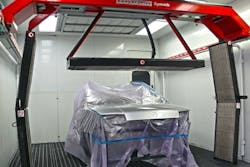For the first time in 70 years of business, Greg Gilmore says his shop has reached its full potential.
Gilmore’s Collision Center, out of Wichita Falls, Texas, has come a long way from its humble beginnings, and the owner credits the recent elimination of paint department bottlenecks, reduction in cycle time, improved insurance relations and gas savings of $1,500 per month to robotic drying equipment, which allows his shop to rapidly dry and cure paint, primer and filler.
These are all typical benefits you can expect to see, says Steve Trapp, North American services manager for Axalta Coating Systems, who took a tour of nine European shops housing gas catalytic drying technology before returning to the U.S. to help several businesses implement what many consider to be the future of paint drying in collision repair.
But it will be impossible to realize those benefits unless you, your staff and your shop’s processes are fully prepared, he says. And while there are half-arch and handheld systems available, full-arch units in your paint booths or prep bays provide a great benefit, both Gilmore and Trapp say. “If you choose to put in the full arch for drying, you don’t need a prep shop anymore,” Trapp says. “Your prep department can become body and you can push more cars through.”
Bottom line: If you’re prepared for that level of change, your bottom line will likely improve—but if you’re not ready, you’ll end up replacing old bottlenecks with new ones. To prepare, Gilmore and Trapp spoke with FenderBender to cover the research you should conduct and what changes to expect in your shop once it’s installed.
Before You Start: Make Sure You’re Operating at Full Capacity
When shops come to Axalta for a facility redesign, Trapp says, a majority of the time, they’re not running at capacity.
“What that’s telling me is they are equipment junkies and they like to add on to their shop, even if it’s not the smart thing to do,” he says.
To get the most out of robotic drying equipment, Trapp recommends your shop be “at 100 percent capacity,” otherwise, you won’t be feeding the paint booths enough work to make it worth the investment.
Know the Companies
As of now, three companies hold patents for full-arch robotic drying equipment: Symach, Greentech, and Ionitec.
Since the technology originated in Europe, equipment and service within the U.S. is limited. A transaction may require a shop to deal with international shipping and customs. And if your equipment requires service, a significant difference in time zones could make that more difficult.
Depending on your budget and openness to training and renovations, each company will present pros and cons, Trapp says.
Symach requires months of planning and blueprinting to install in either a brand new, empty facility or an existing facility that will need to be fully renovated.
Technicians are sent to shops for a few days of training to help implement lean repair practices that conform to Symach’s system. Visit symach.com for more details.
Greentech (commonly known as Robotica) will provide machines to anyone, regardless of constraints in the paint and body shop. However, while it doesn’t require full-scale remodels, the company that distributes it, Bodyshop Revolution, will work more extensively with shop owners that want to implement the company's lean-focused production systems. It also offers technical training and offers a program on the Theory of Constraints to achieve full optimization. Visit bodyshoprevolution.com for more details.
Ionitec can be set up freely in any shop. The distributor, D&S Curing Solutions, has no shop requirements and doesn’t offer any sort of process training—although it will send out representatives for technical training. Visit dscuringsolutions.com for more details.
Conduct the Research
Trapp says the complicated, costly technology can break your shop as much as it can make it and requires a deep understanding before implementation of the systems—so make sure to do your research.
Understand the technology. The full robotic arch, which is powered by electricity and natural gas, is a computer-operated system with touchscreen controls. It is mounted to the paint booth ceiling and passses over a vehicle at roughly three feet per second.
Since this technology is new, Trapp says few have a grasp on how it works. A breakdown of how gas catalytic technology functions can be found at fenderbender.com/robotic-drying.
Consider the costs and ROI. The price tag for each company’s equipment varies greatly, depending on whether you require full-facility makeover, whether your equipment is shipped from outside the U.S., and the level of training your staff will require.
The full-arch system at Gilmore’s shop came in around $120,000. While every setup isn’t that expensive, Trapp says you can expect to spend between $50,000 and $100,000. You can expect to add on thousands if your paint booth controls need to be updated to work effectively; you need to purchase a new booth; you purchase a bumper dry chamber.
Trapp says your return on investment will be made up of natural gas savings (expect reductions of 60-70 percent) over a few years (depending upon natural gas costs), plus the increased output of the paint shop.
Consult similar shops. Gilmore visited a Portland shop before purchasing his robotic drying equipment. Gilmore says that as the technology becomes more popular, you’ll have more opportunities to visit shops housing the equipment. He says it’s important to connect with shops that have a similar size and output and share the same paint supplier.
Be Prepared for Change
While speeding up the drying process is the ultimate goal, Gilmore and Trapp state it will create some changes in your shop you should be prepared for:
New bottlenecks. Eliminating one bottleneck could end up creating another. Unless you’re ready to alter your entire repair process, Gilmore says you won’t be fully optimizing the system and your cycle time will not improve. Be sure you’re blueprinting every vehicle and have a system that keeps a consistent flow through the booth.
“It eliminated the bottlenecks we had in our paint shop, but that also meant our disassembly team was getting overloaded,” he says. “We were feeding them cars faster than they could put them together. We made some adjustments there, so that as soon as these cars had come out and cooled, we could jump right on them.” Trapp says to be ready to refine your prep-to-stage-to-paint ratio.
“You need enough inventory to feed the prep. Then the prep then has to move to stage, and the stage has to be set so the moment that booth door opens, there’s something staged and ready to go,” he says. “Otherwise, this is a bad investment. If you don’t know how to optimize the full series, you will not get an ROI for this.”
Altered staff roles. With cars entering the reassembly stage more quickly, Gilmore’s shop experienced an overload that required staffing readjustments to keep up with the workload. He switched his employees to a team system and now transitions technicians into the reassembly process throughout the week.
“Guys that normally tear down cars and blueprint at the beginning of the week will shift over and reassemble more cars at the end of the week,” he says.
Extra space. Trapp says many of the shops he’s consulted have eliminated the need for prep decks.
“At the end of the day, the arch is drying the primer, so you don’t need the priming area,” he says. “Then you have a new layout. Your body area can become much larger as the staging and final prep areas are way smaller than they have traditionally worked.”
Trapp says this freed-up space has presented many shops an opportunity to open a lane for fast-track jobs. Gilmore says his shop is now capable of pushing out bumper jobs and small repairs within one day.
Different paint and chemicals. One major change that Gilmore’s shop had to make was choosing a clear that performed better with the new equipment. He says the same could go for any other chemicals—such as hardeners and reducers—and your paint line.

